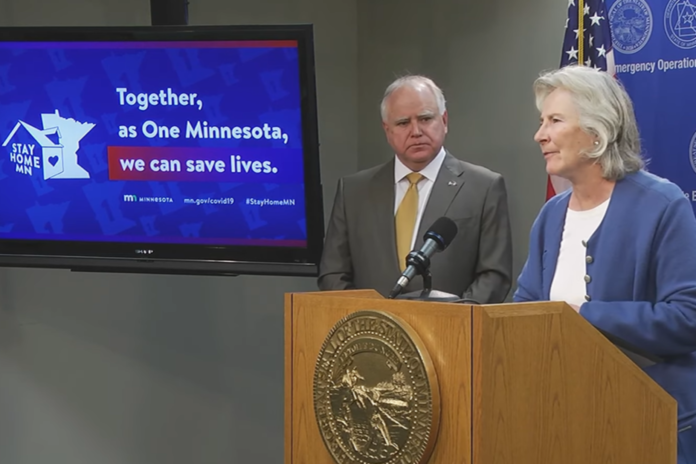As coronavirus cases have surged in the Upper Midwest and other parts of the country, a number of governors have assigned blame to their citizens. Our governor has taken the same course, claiming, with no support, that failure to follow recommended mitigation measures is the cause of the case rise, that Minnesotans’ behavior is at fault. He has warned that if we don’t change our behavior, cases, hospitalizations and deaths will rise even further.
Let’s examine the truth of that assertion. In order for some supposed behavior or lack of behavior to be associated with the case increase, the behavior would have to have changed before and along with the rise in cases. It hasn’t. In regard to mask wearing, for example, every survey shows that if anything mask wearing in the state has increased since the summer when cases were low. Mobility patterns haven’t changed. In fact, they have declined slightly in recent weeks, according to the CDC COVID Data Tracker. There is no demonstration that people are gathering more, in fact the opposite is almost certainly true when summer ends in Minnesota.
Since changes in behavior can’t account for the increase in cases, what does? The answer is obvious. Seasonal coronaviruses are called seasonal for a reason — they have a very clear seasonal pattern which peaks in the winter, diminishes in late spring and re-emerges in the fall. This coronavirus is following that pattern. The virus finds fall’s cooler, less humid weather and the much lower amount and intensity of sunshine a far more hospitable environment. These factors may be enhanced by changes in human biochemistry, such as lower vitamin D levels. What makes more sense, that a non-existent behavior change is responsible for more cases or that it is due to a well-documented seasonal pattern to coronaviruses?
The likelihood of a renewed increase in cases in the fall has been apparent since the start of the epidemic and the governor has even referenced it in the past. Yet here we are, apparently completely unprepared for the extent of the case rise and in scrambling, panic mode again. That was somewhat understandable in the spring, but not now. And once again, we see actions taken to limit spread with no analysis of all the consequences, or even the likelihood of effectiveness against a respiratory virus that has shown itself to be extremely resistant to mitigation measures.
The governor’s repertoire of responses to this epidemic has been largely incompetent and ineffective. He issued stay-at-home and business and school closure edicts with no analysis of the impact, including the effect on minorities and low-income persons, who always are the most hurt by such actions. And the citizens of the state as a result lost hundreds of thousands of jobs and thousands of businesses; children have been deprived of a meaningful educational and social experience; and thousands have missed needed health care.
Despite very early warning that this pathogen targeted the frail elderly, nothing was done to protect long-term care residents. Then when the disproportionate toll on this group was apparent, we were graced with the “battle plan.” If that is a war, coronavirus has won. We continue to see the vast majority of our deaths, around 75%, occurring among residents of these facilities.
He has sent the state down a massive testing rabbit hole, with no real purpose, which merely adds to the work of our thousands of contact tracers who haven’t been able to find the source of transmission of even half of the state’s known cases, much less all the undetected ones. Many of these tests result in false positives and low positives that don’t reflect infectious persons. People are put in quarantine limbo trying to figure out if they really are positive.
Despite claims of having the best data in the country and being very transparent, the state does not report on such basic issues as the actual date that deaths occur, not the date they are reported; the number of supposed coronavirus hospitalizations that were for another purpose and the patient happens to test positive; the number of hospitalizations in which the person acquired the infection in the hospital; daily hospital census; average length of stay; how the positivity rate is actually calculated; the distribution of cycle numbers on supposedly positive PCR tests and on and on. We get no reporting on the myriad health harms caused by his orders, including over 1500 Minnesotans over the average who have died of certain causes other than coronavirus. These unfortunates include dementia patients who are subjected to lethal isolation, cancer patients who have missed treatments and heart attack victims afraid to go to the emergency room.
Instead of leadership we get anecdotal appeals to emotion, such as dragging out coronavirus sufferers to shame us all, and finger-wagging at our irresponsible actions. Instead of calm, rational reassurance, we have had a constant campaign of terrorization, which has led to people in the general population having an extremely exaggerated sense of the actual risk. Not once have we heard from the family of one of those excess non-coronavirus deaths, from the parents of children whose lives are being irreparably harmed by missing real school, from the families of suicides or drug overdoses prompted by despair, or a business owner whose dream has been shattered. Almost all Minnesotans have endured a serious diminution of their quality of life for over eight months. And now we are told it is largely our fault. The governor might do well to look in the mirror before lecturing Minnesotans.
– – –
This article was originally published at the Healthy Skeptic and was reprinted here with permission.











